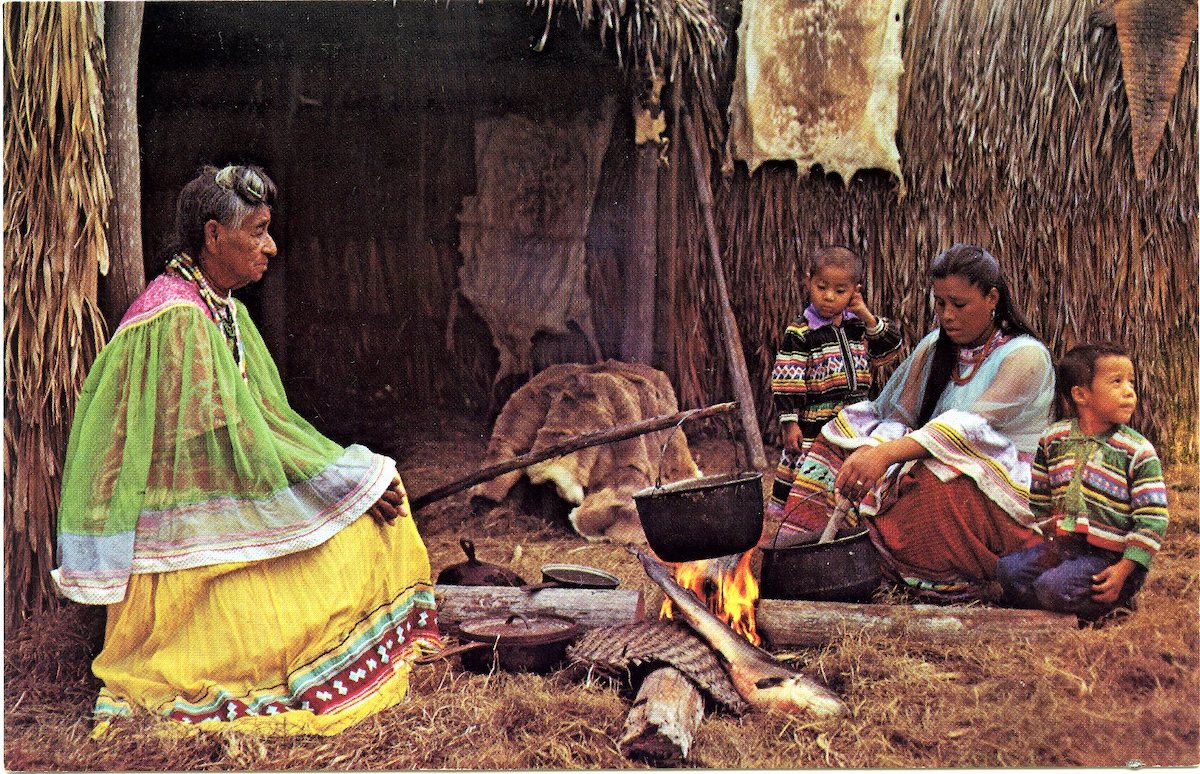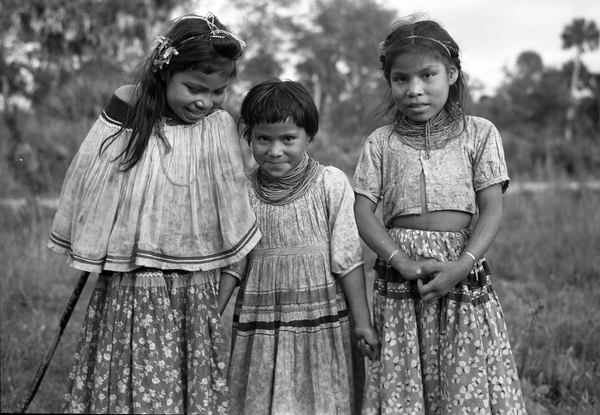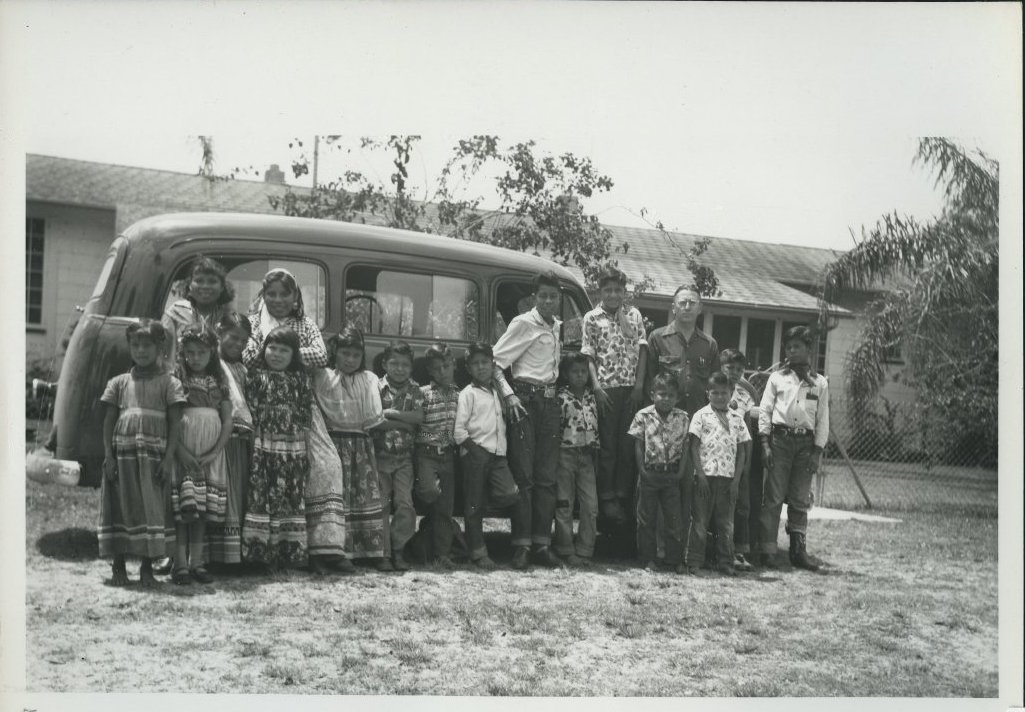
Faith and Family: The Quiet Legacy of Ada Tiger
Today is the first day of Women’s History Month! Throughout March, Florida Seminole Tourism is spotlighting significant Seminole women every week on our blog. This week, you will learn about a formidable and resilient cattlewoman. She left a lasting imprint on Seminole history, her family, and Seminole cattle. Our celebration kicks off with none other than Ada Tiger (Snake Clan)!
In our featured image for this week, you can see a postcard featuring two women and children around a Seminole camp fire. Ada Tiger sits to the left, and Agnes Tiger and her two sons sit to the right. The original image was taken at Okalee Seminole Indian Village in the 1950s or 60s. Each day, the camp was artificially set up to share traditional Seminole camp life with tourists. Below, you can see an image of Ada Tiger (left) doing beadwork circa 1961. She sits outside of a chickee with Marie Willie Osceola (wife of Jimmy Hank Osceola) who is holding her son Jimmy Hank Osceola, Jr.

The Lone Cattlewoman
Half Creek and half Miccosukee, Ada Tiger and her family initially kept their camp around Lake Okeechobee. Tiger became a cattlewoman, or cowkeeper, through necessity. She had inherited her herd from her three brothers, “each of whom had succumbed to tuberculosis or pneumonia within five years between 1914 and 1916 (Oct 2022, Seminole History Stories, STOF-THPO).”
To support her family, Tiger took on the management of their herd. She raised and trained two “cow-chaser” dogs to help wrangle the cattle, but otherwise worked almost entirely unaided. Tiger did not use any fences or pens. Instead, “she kept them well-fed with corn grown by the family, and worked the area around the camp to ensure it was a place the cattle would want to stay in” (Oct 2022, Seminole History Stories, STOF-THPO). Although women have been involved in Seminole cattle since the beginning, Ada Tiger’s management of her family’s herd set an impressive example.
During the 1920s, Tiger would make the trek into Indiantown, FL to sell cattle, treat the rest for fleas, and buy essential goods. She would make this ten-mile journey twice a year, before returning to the family camp. By this period, Tiger was managing the largest herd of any Seminole at the time. Some reports place her herd in the hundreds, an impressive feat of any solo cowkeeper. Later, her daughter Betty Mae Jumper would reminisce of their time in the family camp and how the cattle supported her family. “We were never hungry,” Jumper remembers of their early years in Indiantown (23 Mar 1997, South Florida Sun Sentinel). Unfortunately, this time of comfort would not last.
Move From Indiantown
By 1927, Ada Tiger had left Indiantown. But, this was another decision born of necessity and not desire (May 8 1927, West Palm Beach Post). Ada Tiger had given birth to her daughter, Betty Mae Jumper, who was half-white. This opened up the family, but especially Betty Mae, to danger. “The fear and hatred of the white men still ran hot in the blood of Tribal leaders and medicine men,” Jumper would recall later. “All half-breeds were killed” (08 Nov 1998, The Orlando Sentinel).
When Seminole leaders came to kill Betty Mae, her family turned them away with shotguns. But, this told Ada all she needed to know; they needed to leave. Tiger sold as much as she could. She abandoned the rest, bought a Ford model-T, and moved her family to the Dania (now Hollywood) Reservation.
Tiger’s resilience and determination carried the family through the hard times. Jumper recalled that her mother and grandmother (Mary Gopher Tiger) “didn’t know how to work in the white man’s world” (23 Mar 1997, South Florida Sun Sentinel). Tiger and her mother worked in the fields, picking beans and tomatoes. On the 1940 census, Ada Tiger listed her occupation as “makes souvenirs.” At that time, her household consisted of her mother (then 80) and two children (then 18 and 15), and her rent was $10 a month (07 Apr 2012, South Florida Sun Sentinel).
Ada Tiger would also fight for her daughter to attend school. Once, she even tried to enroll her in a black school since the white ones would not take her. She personally did not encourage it one way or another, but supported her daughter in her dreams. Eventually, Betty Mae would go to school in North Carolina, beginning at age 14 (23 Mar 1997, South Florida Sun Sentinel).

On the Dania Reservation
Ada Tiger would live the rest of her life on the Dania Reservation. She passed away at the age of 87 in 1970. Although not much is written down about her later years in Dania , glimpses can be seen in newspaper articles and anecdotal memories from her children, particularly Betty Mae. Dedicated to her family and community, Ada’s name often comes up in connection with Seminole school children’s programs.
In 1936, children at the Dania Seminole Indian School wrote about visiting her family camp, where they ate Venetian eggs with tomatoes, onions, cheese, and bacon, carrot fingers, brown bread and butter sandwiches, milk, and oranges for dessert. Ada Tiger was picking huckleberries (25 May 1936, Fort Lauderdale News). At the end of that same school year, Ada would participate in a program with her son to mark the beginning of summer break (05 Jun 1936, Fort Lauderdale News).
Although she only spoke Miccosukee, Tiger also shared memories in a news article in 1968 through an interpreter. In it, she reminisced about her heritage, and how delicious gar fish are even though white men call them junk fish. She talks of crafting, of making dolls, woodwork, and clothing and selling them to tourists. During the interview, she sat making beadwork. The author states: “She wears the Seminole dress. The days is cold but she sits on the ground in the pale sunlight. Before her is a cloth and on it beads….Despite her [85] years she doesn’t wear any glasses. Perhaps she wouldn’t even have to look at her creation…because she has been making gifts for so long” (17 Nov 1968, Fort Lauderdale News).
Faith and Christianity
Ada Tiger was one of the first Christian Seminoles, baptized in 1916. In a Seminole Tribune article about Seminoles and Christianity, Ada Tiger and the Snake clan particularly are credited with being the first to spread the gospel in the Seminole Tribe. In the early part of the 20th century, “conversions came from members of a Snake Clan family that included Mary Tustenuggee Tiger, Ada Tiger, the Tommie family of Annie Mae, Tudie, Jack and Sam as well as children, and Lena, Pocahontas and Frank Huff.” An accomplished medicine woman, as well as being a devout Christian, Tiger carried both her culture and heritage as well as her faith with her throughout her life.
Tiger’s steadfast belief traveled down from her to her children and community and became a part of her family’s heritage. The article emphasizes this, saying: “The power of Christianity traveled from Ada Tiger to her daughter Betty Mae Tiger Jumper, a religious and political leader, educator, writer and humanitarian. [Betty Mae Jumper’s] son Moses Jumper Jr. is a lay pastor and has coordinated youth and recreation programs for the Seminole Tribe as well as the Big Cypress First Seminole Baptist Church. His son Josh Jumper has furthered his education with Christian studies, organized youth groups and recently became a licensed pastor.”
Ada Tiger’s grandson, Moses Jumper Jr., dedicated his book of poetry Echoes in the Wind to the memory of his grandmother. In the dedication, he says it was “for her insight and love for her family, her people, and the spiritual respect she showed God and all His Creation” (28 Sept 2008, Miami Herald).
Legacy
Ada Tiger’s legacy can be seen not only in Seminole cattle, but in the lives and dedication of her children and grandchildren. Tiger had two children, Betty Mae Tiger Jumper and Howard Tiger. You may remember we have talked extensively about Betty Mae before on our blog. Eventually becoming a nurse, Betty Mae learned Seminole healing and midwifery from her mother as a young child. Tiger’s son, Howard, was the first Seminole to enlist in the United States military. He would fight at Iwo Jima. Both children would go on to have a long influence, and both would eventually become Chairman and Chairwoman (respectively) of the Seminole Tribe of Florida.
Check back in next week for the next installment of our Women’s History Month Series! Who will we feature next?
Author Bio
Originally from Washington state, Deanna Butler received her BA in Archaeological Sciences from the University of Washington in 2014. Deanna moved to Florida in 2016. Soon, she began working for the Seminole Tribe of Florida’s Tribal Historic Preservation Office. Deanna was the THPO’s Archaeological Collections Assistant from 2017-2021. While at the THPO, Deanna worked to preserve, support, and process the Tribe’s archaeological collection. She often wrote the popular Artifact of the Month series, and worked on many community and educational outreach programs. She lives in Lakeland, FL with her husband, two sons, and dog.



